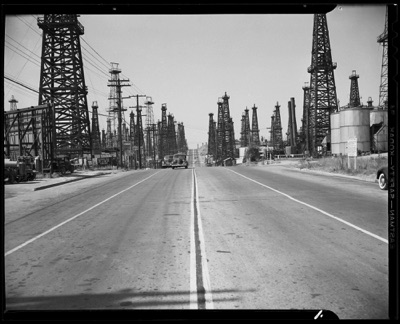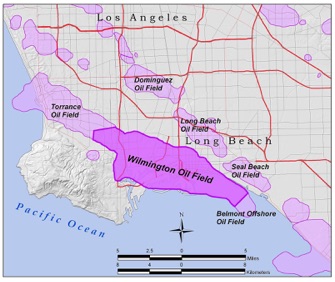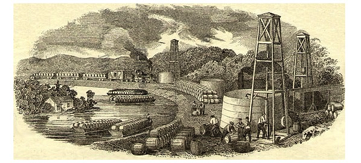The Story of Oil in California
Many people may be surprised to learn that one of Southern California's chief exports over the last 100 years, besides motion pictures, has been oil. Like oil reservoirs in Texas, Louisiana, and Pennsylvania, a hint of what lay beneath the surface could be seen in the many above ground oil seeps. These seeps had been known by Native Americans for thousands of years. In 1543, Spanish explorer Juan Cabrillo noticed the native people using the naturally occurring tar, or "pitch", to waterproof their canoes. These seeps were also responsible for the tar pits of La Brea (Spanish for "pitch"), which had, over many thousands of years, trapped unsuspecting animals and their predators looking for an easy meal.
In 1865, only 6 years after "Colonel" Edwin Drake's monumental discovery in Pennsylvania, California's first productive well was drilled by the Union Matolle Company in California's Central Valley. This area, east of San Francisco, became the scene of much of the drilling activity through the rest of the 1800's. While none of these wells were considered major strikes, they did provide enough oil for the nearby market of San Francisco, by far the largest population center in California in the late 1800's.
It came from over there....
But the largest fields lay undiscovered, near the sleepy seaside village of Los Angeles. The first well to strike oil in Southern California was drilled in 1892 by Edward L. Doheny, an unsuccessful gold and silver prospector, and Charles A. Canfield, his old mining partner. According to legend, Edward L. Doheny was in the downtown area of Los Angeles when he saw a cart whose wheels were coated in tar. When he asked the man where the substance had come from, he pointed to the northeast. Doheny and Canfield examined the area and soon discovered the Los Angeles Field after drilling to a depth of 140 meters (460 feet) at the corner of Colton Street and Glendale Boulevard, near present day Dodger Stadium. It was drilled using the unlikeliest of instruments: a sharpened end of a eucalyptus tree. Within 2 years of the find, 80 wells were producing oil in the area bounded by Figueroa, First, Union and Temple Streets. By 1897, the number of wells increased to 500.
Rise to Fame
Doheny would eventually become a millionaire, and gain enough renown to challenge for the Democratic nomination for Vice-President of the United States in 1920. And although he was cleared of any wrong-doing, he would later become a central figure in the Teapot Dome Scandal of the 1920's which brought disgrace to the presidency of Warren G. Harding. Not surprisingly, oil was at the center of the scandal.\
The Oil Queen
A local music teacher, Emma Summers, was one of the most successful investors in the first years of the initial boom, and by 1900, Summers controlled half the production in the original Los Angeles Field. For obvious reasons, Summers became known as "California's Petroleum Queen."
The oil boom in the early days attracted some interesting characters, including prostitutes, gamblers and con-men. The population of the city of Los Angeles doubled between 1890 and 1900, then tripled again between 1900 and 1910. Later, wells in the 1930's and 40's were soundproofed with vinyl-coated glass cloth with one-inch sheet fiberglass filling to decrease the noise, as the drilling activity began to conflict with the exploding Los Angeles population. Camouflage was also used, a technique that was eventually moved to offshore fields as well.
In 1900, the state of California produced 4 million barrels. In 1910, this had jumped to 77 million barrels. In spite of this increased production, many of the fields were beginning to see slowdowns in their production rates in the late 1910's, and California's wondered if their oil boom was reaching an end. But before that would happen, 3 major fields were discovered in rapid succession - Huntington Beach (1920), Santa Fe Springs (1921), and the biggest of them all, the Signal Hill, or Long Beach, Field in 1921.
Source: The Paleontological Research Institution 1259 Trumansburg Road • Ithaca, NY 14850


Atlantic Avenue and Patterson Street, Long Beach, are lined with oil derricks in 1940.
Looking North on Atlantic.
Memorial Hospital would be on the left today.
(Dick Whittington Studio/Corbis via Getty Images)
Oil Fields near Signal Hill
Panorama of Signal Hill. ca 1923


